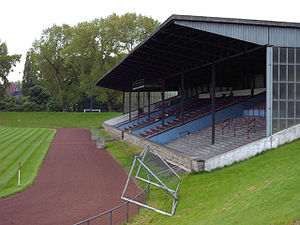Glückauf-Kampfbahn
| Glückauf-Kampfbahn | |
|---|---|

|
|
| The listed main grandstand | |
| Data | |
| place | Ernst-Kuzorra-Platz 45881 Gelsenkirchen , Germany |
| Coordinates | 51 ° 31 '48 " N , 7 ° 4' 46" E |
| owner |
Land: Mannesmannröhren-Werke Buildings including stadium: Schalke 04 (1928–1965) City of Gelsenkirchen (since 1965) |
| start of building | August 1, 1927 |
| opening | September 2, 1928 |
| First game | August 25, 1928 FC Schalke 04 - SpVgg Sülz 07 |
| Renovations | 1946, 1989 |
| surface | artificial grass |
| capacity | 11,000 seats (currently) 34,000 seats (originally) |
| Societies) | |
|
|
The Glückauf-Kampfbahn (officially Kampfbahn Glückauf ) is a football stadium in Gelsenkirchen . It was built from August 1927 on the site of the former Consolidation colliery . The official opening ceremony took place on September 2, 1928. Until the Park Stadium was built in 1973, the arena served as the home ground of FC Schalke 04 .
history
On the day of the inauguration, there were various attractions, including a field handball game by the handball department of the Gelsenkirchen team against the Cologne club for lawn games , an athletics competition and a soccer game against Tennis Borussia Berlin , which Schalke 04 won 3-2. Previously, on August 25, 1928, there had already been a friendly game between Schalke and the reigning West German champions SpVgg Sülz 07 in the arena.
Originally the arena located in the middle of Schalke was planned as a pure standing stadium, but a few weeks before the opening, 1,200 additional seats were set up. This was unusual for a workers' club like Schalke, until well into the 1930s, grandstands were considered a privilege of stadiums of the bourgeois “patent leather clubs”. As early as 1931, 70,000 spectators flocked to the friendly game between FC Schalke 04 and Fortuna Düsseldorf - this number is still the record number of spectators for games on the arena. However, since the stadium was only designed for 34,000 fans, it was expanded to include the 114-meter-long main stand in 1936, but it remained too small for the crowds.
After the war, the stadium, which had been almost completely destroyed at the end of 1944, was restored and, apart from minor structural measures, remained unchanged in the period that followed, despite existing expansion plans; Ticket booths were built in 1950, followed by floodlights in 1956. The last Bundesliga game played by Schalke in the arena was a 2-0 win against Hamburger SV on the last day of the 1972/73 season . In the late 1980s, the standing room was torn down except for the main grandstand, which is now a listed building, so that the stadium now only holds around 11,000 spectators. The stadium was used by the Schalke youth teams until January 2006, today DJK Teutonia Schalke-Nord still plays here.
The Gelsenkirchen Fan Festival took place here during the 2006 World Cup . In June 2006 the stadium was Monument of the Month in Westphalia-Lippe .
Web links
- Gelsenkirchen ISG memorial site at Glückauf-Kampfbahn
- Schalke 04 to the former venue
- Extensive picture gallery
- Description of this sight on the route of industrial culture
Individual evidence
- ↑ The goals for the hosts scored Ernst Kuzorra (2) and Emil Rothardt ; Sepp Herberger played with the Berliners . Thomas Spiegel / Gerd Voss: Consecration of the fight track "Glückauf" , in: Almost everything about Schalke 04 , KiWi paperback, Cologne 2009, ISBN 978-3-462-04101-9 , p. 153
- ↑ The game ended in a draw 3: 3. Thomas Spiegel / Gerd Voss: Debuts in New Stages , in: Almost everything about Schalke 04 , KiWi paperback, Cologne 2009, ISBN 978-3-462-04101-9 , p. 122
- ↑ cf. www.glückaufkampfbahn2006.de ( Memento of the original from March 12, 2009 in the Internet Archive ) Info: The archive link was inserted automatically and has not yet been checked. Please check the original and archive link according to the instructions and then remove this notice.
- ↑ For the game of SV Sodingen against 1. FC Kaiserslautern in the final round of the German championship in 1955, over 80,000 spectators are said to have made the pilgrimage to the arena - in both cases, however, there is no official information about the number of those who actually found their way into the stadium.
